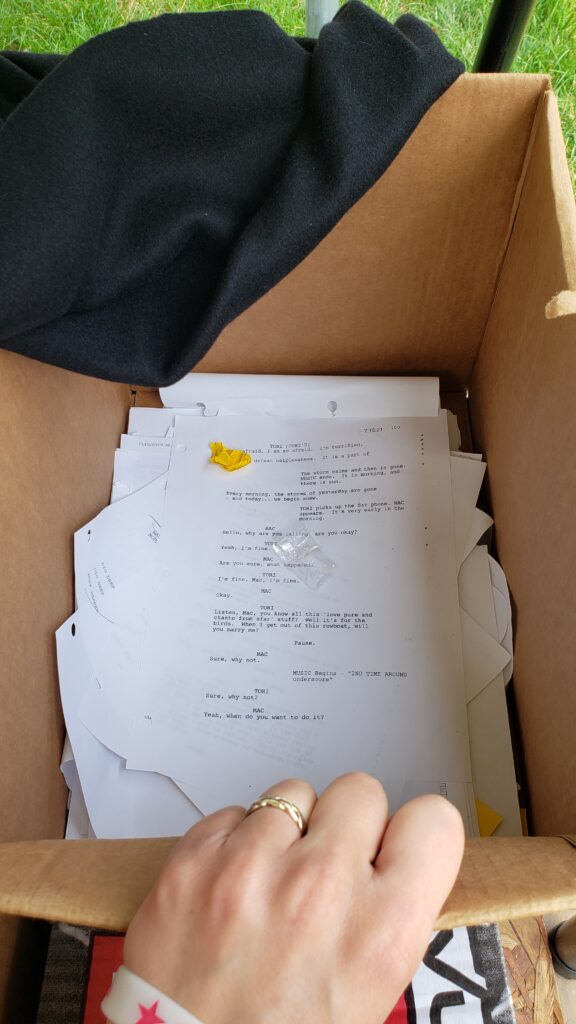Getting any show up and running is hard. Layers upon layers of new information are being added to the piece once the actors move from the rehearsal space to the performance venue, and it’s all happening very quickly. As a show’s A1, I am hard at work preparing my script, generating paperwork, programming the console, and in some cases also working as a hand on the shop build and/or load-in. Design elements are coming together throughout the tech process. Ideas are tried, then retooled, and tried again. However, one thing that usually isn’t changing is the actual script of the show. Not so on new work!
New pieces, and especially new musicals, come with their own set of unique challenges. Sometimes members of the writing team are present throughout the rehearsal process, making rewrites and changes to the piece as it gets staged. Rehearsal reports sent out by the stage manager will include new script pages and/or change logs, all of which can make it harder to get familiar with a show in advance of tech and previews. Songs may be moved around in the script, new scenes or characters might be added, entire sections may get cut. The entire product is constantly evolving!
Personally, new musicals are my favorite kind of shows to work on, despite all these added challenges. In fact, part of why I love them so much is precisely because of these added challenges! It’s really special to be part of a work that is being shown in its full form for the first time, and it really does keep me extra engaged when I’m in the tech and preview process. The audience has no preconceived notions of what the show is going to look or sound like, and as the mixer, my role in facilitating the storytelling is even more crucial, because no one has ever heard it before!
So, how should one approach the preparation process when mixing a new musical? In general, the process is the same as with existing work, just with a few added hurdles.
Do your homework as per usual
Familiarize yourself with the material in advance as best you can, whether it’s through demo recordings or by watching run-throughs in the rehearsal hall. The new musical I am currently mixing was meant to be produced in 2020, but due to the pandemic, it was adapted into a radio play and released on audible, with the fully staged production postponed to this summer. So, since a new musical likely won’t have a cast album yet, I was able to use that audible recording to do my “homework” of getting to know the general feel of the scenes and songs, even though I knew that the show would likely change a lot in the year that passed between when the radio play was recorded and this summer when we would finally get to do the show for an audience.
Prepare for new pages
This is probably the most labor-intensive part of the prep process on a new musical. As the script changes, whoever is tracking those changes (usually someone from the writing team or stage management) will bring you new replacement pages to insert into your book, or a change sheet with lines that you should write in on your own (some shows do one or the other, on my current show, Row, they do both). This means you’ll be doing quite a bit of transferring your notes from old pages to new ones. For that reason, it’s all the more important to develop a shorthand for yourself that you like, so that you can do all this rewriting as quickly as possible. For example, I will abbreviate my Band Master fader as “B” and my Vocal reverb fader as “V”, then I use musical crescendo/decrescendo markings for my dynamic moves. Writing “B < -5” is a lot faster than having to transfer the full words over and over again every time a new page comes in! Other little symbols I like to use are up and down arrows for pickups, slashes for when characters’ lines overlap, and my favorite, a little glasses symbol for when you should look at something specific for a cue (this is a common practice among musicians to remind themselves when they should watch the conductor).
Don’t get rid of your old pages!
As Gibbs’ Rule #11 teaches us, “Everything is subject to un-change.” A new scene might not work, and you might go back to the old scene. Keep all your change logs and cut pages handy in case you need to re-insert them or reference them for any reason. Fun fact: I once did a new musical whereby the end of the run, my stack of cut pages was basically the size of the finished script!
Practice but don’t memorize yet
As you mix a show more and more times, you will naturally begin to develop muscle memory for making your pickups and fader moves. However, on new work, it’s important to not let habits set in too soon in case things keep changing. I have on occasion caught myself making errors because my hands got too used to doing a scene a certain way and then the scene was re-written. Pay extra attention to any lines that you use as cues for yourself in case they change!
Consult all your sources
Since we’re talking specifically about musicals, it is likely that songs will change in addition to book scenes as the show develops. Make sure that you are getting updates from the music department in addition to the ones you get from writing/stage management. Sometimes the piano/vocal will have more current information than the libretto! Also, even if you don’t read music, it can be super helpful to have access to the piano/vocal score to consult as you figure out the timings of band moves and console scenes.
Try to program flexibly
As a general rule, it’s good to leave yourself “buffer” console scenes/snapshots as you program in case you decide you need to add things or adjust DCA assignments. This is even more true on a new musical. For example, the console on Row is a Yamaha CL5, which can accommodate up to 300 console scenes. When I laid out my DCA tracking prior to programming the show, it looked like I would need about 60 scenes to do the whole show. So rather than start at Scene #1 and go sequentially, the first song is scene #10, the second song is scene #15, etc. That way I have room to add more scenes internally without having to renumber every subsequent scene. To save time and hassle, also try to program in a more minimalist way than you might on an existing show so that you can adapt to changes more easily. Inevitably you will find yourself having to go through 10 separate console scenes to make a single change to all of them because of a script/song change, but the fewer times you have to do this the better. ☺
The thing to remember most of all on a new musical is that while rolling with the punches as things change can be stressful, it’s all in service of the art. I once worked with a choreographer who when he needed to adjust something would say on his god mic “I’m making a change” and the whole company would reply “Change is GOOD!” I’ve made that quote my new musical motto. The reward of knowing that all of the work that the creatives are putting in (and you alongside them) is truly helping to tell the story better will make it worth it when the show finally gets “frozen” (this means no more changes are allowed) and makes its world premiere in front of its first-ever audience!

